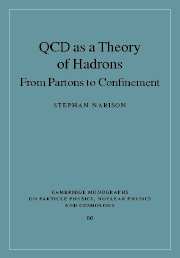Book contents
- Frontmatter
- Contents
- About Stephan Narison
- Outline of the book
- Preface
- Acknowledgements
- Part I General introduction
- Part II QCD gauge theory
- Part III MS-bar scheme for QCD and QED
- Part IV Deep inelastic scatterings at hadron colliders
- Part V Hard processes in e+e– collisions
- Part VI Summary of QCD tests and αs measurements
- Part VII Power corrections in QCD
- Part VIII QCD two-point functions
- Part IX QCD non-perturbative methods
- Part X QCD spectral sum rules
- 47 Introduction
- 48 Theoretical foundations
- 49 Survey of QCD spectral sum rules
- 50 Weinberg and DMO sum rules
- 51 The QCD coupling αs
- 52 The QCD condensates
- 53 Light and heavy quark masses, etc
- 54 Hadron spectroscopy
- 55 D, B and Bc exclusive weak decays
- 56 B0s-B̄0s Mixing, Kaon Cp Violation
- 57 Thermal behaviour of QCD
- 58 More on spectral sum rules
- Part XI Appendices
- Bibliography
- Index
58 - More on spectral sum rules
from Part X - QCD spectral sum rules
- Frontmatter
- Contents
- About Stephan Narison
- Outline of the book
- Preface
- Acknowledgements
- Part I General introduction
- Part II QCD gauge theory
- Part III MS-bar scheme for QCD and QED
- Part IV Deep inelastic scatterings at hadron colliders
- Part V Hard processes in e+e– collisions
- Part VI Summary of QCD tests and αs measurements
- Part VII Power corrections in QCD
- Part VIII QCD two-point functions
- Part IX QCD non-perturbative methods
- Part X QCD spectral sum rules
- 47 Introduction
- 48 Theoretical foundations
- 49 Survey of QCD spectral sum rules
- 50 Weinberg and DMO sum rules
- 51 The QCD coupling αs
- 52 The QCD condensates
- 53 Light and heavy quark masses, etc
- 54 Hadron spectroscopy
- 55 D, B and Bc exclusive weak decays
- 56 B0s-B̄0s Mixing, Kaon Cp Violation
- 57 Thermal behaviour of QCD
- 58 More on spectral sum rules
- Part XI Appendices
- Bibliography
- Index
Summary
QSSR have wider applications and can also be applied to theories other than QCD as it is based on first principles of analyticity and duality.
Some other applications in QCD
Some other applications of QSSR have been already reviewed in details in the book [3], which we list below:
Baryons at large Nc.
String tension from Wilson loops.
Relation between lattice correlators and chiral symmetry breaking in the continuum limit.
Two-dimensional QCD.
Electroweak models with dynamic symmetry breaking
QSSR has been also extended in order to give dynamic constraints on fermions and W, Z bosons assumed to be bound states of preons (haplons) where the structures may manifest at the TeV scale. The analysis has been done by assuming that at that scale, one can have a strong interaction theory of preons that is closely analogous to QCD describing the electroweak interactions, with the exception that one has to be careful on the chirality of the theories:
In [868] and [869], (reviewed in [870]), QSSR (Laplace and FESR) have been used in order to test the consistency of the compositeness assumption for the W and Z bosons and its spin zero partners, in the haplon model proposed by Fritzsch and Mandelbaum [871], leading to a duality constraint between the boson masses and couplings with the continuum threshold (compositeness scale).
[…]
- Type
- Chapter
- Information
- QCD as a Theory of HadronsFrom Partons to Confinement, pp. 696 - 698Publisher: Cambridge University PressPrint publication year: 2004



